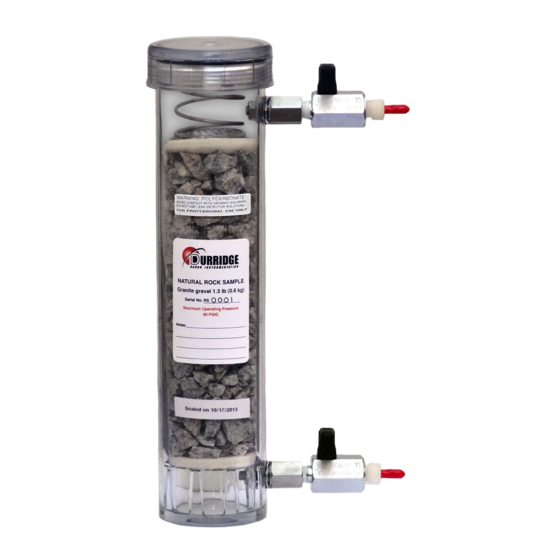DURRIDGE NATURAL ROCK SAMPLE Podręcznik użytkownika - Strona 9
Przeglądaj online lub pobierz pdf Podręcznik użytkownika dla Przyrządy pomiarowe DURRIDGE NATURAL ROCK SAMPLE. DURRIDGE NATURAL ROCK SAMPLE 14 stron. Performance monitoring accessory for the rad7

the slope of the average for all RAD7s should also be maintained, as the radon concentration falls off
over time from decay and any leakage. If during one month the slope is steeper than usual, that would
be an indication of a leak in the loop somewhere.
Although it is possible to combine several RAD7s in a loop for monthly radon sensitivity checks, this
technique will not work for checking thoron sensitivity, due to the decay of thoron in the air as it travels
around the loop (see Section 3.1). However, there is no need to wait between successive thoron checks,
and all the RAD7s can undergo the rough thoron check individually, sequentially, without any delay
between measuring the thoron response of one RAD7 and the next. The monthly protocol may
therefore be:
1. Connect all RAD7s in series, set all protocols to 1-day, set all pumps, except one, to OFF. Put a
Laboratory Drying Unit upstream of the line, with one end open to fresh air.
2. Set the RAD7 with an active pump to Purge, for 15 minutes, to purge all residual radon out of the
RAD7s and start to dry them out.
Test, Start, [ENTER]
3. Select
pump operating).
4. After at least two cycles (1 hour), or preferably 3 cycles (1.5 hours), stop the tests.
5. Disconnect the Laboratory Drying Unit. Connect the string of RAD7s to the Natural Rock Sample
and Small Drying Tube.
6. Open the valves and select
with all pumps, except one, set to OFF).
7. Depending on the precision required, after between 3 and 24 hours, the tests may be stopped and the
RAD7s disconnected.
8. If required, rough thoron checks may then be performed with each RAD7, separately connected to
the Natural Rock Sample. Wait 1-2 hours before doing this, to allow time for the C window radon
counts to decay away (see Section 3.1.1).
9. Careful notes should be kept of all actions and readings, and all data downloaded from each RAD7
to a computer using DURRIDGE's CAPTURE software.
10.The Natural Rock Sample should be thoroughly dried and stored for 30 - 50 days, using the
procedure described in Section 2.3.1, before making the next calibration check.
2.6 Cumulative Spectrum
It is important that the cumulative spectrum (based on counts from multiple cycles) be printed and
inspected periodically. It gives excellent diagnostic information on the health of the instrument. Using
the Natural Rock Sample to check the calibration of the RAD7 every month is a convenient
opportunity to inspect the cumulative spectrum. With the Recycle set to 6 cycles, as indicated above, at
the end of the sixth cycle the RAD7 will automatically finish the run and print out a run summary. This
consists of some data, a bar chart of the six readings and then the cumulative spectrum. That spectrum
should show a sharp peak in the A window, about midway between the boundaries. There may also be
peaks in the other three windows and at 5.3 MeV (210-Po) just to the left of the A window. Please see
the RAD7 manual for a description and image of some possible pathological spectra to watch out for.
Sec$on 2
RAD7 Radon Sensitivity Check
on all RAD7s, starting a 1-day test in each of them (with only one
Test, Start, [ENTER]
on all RAD7s (all still in 1-day protocol and
9
